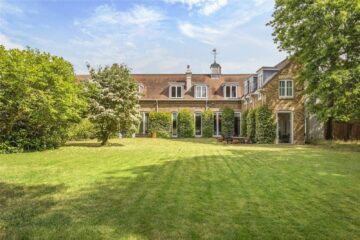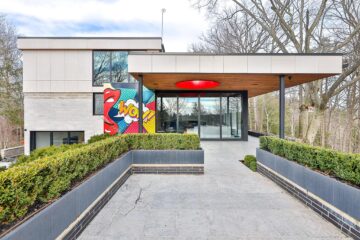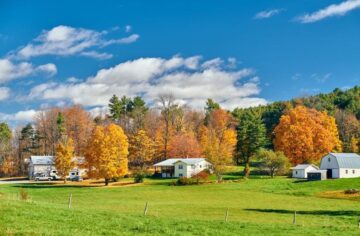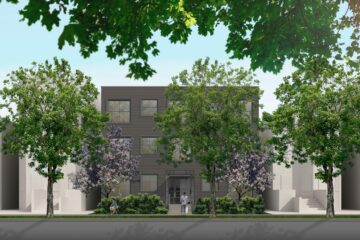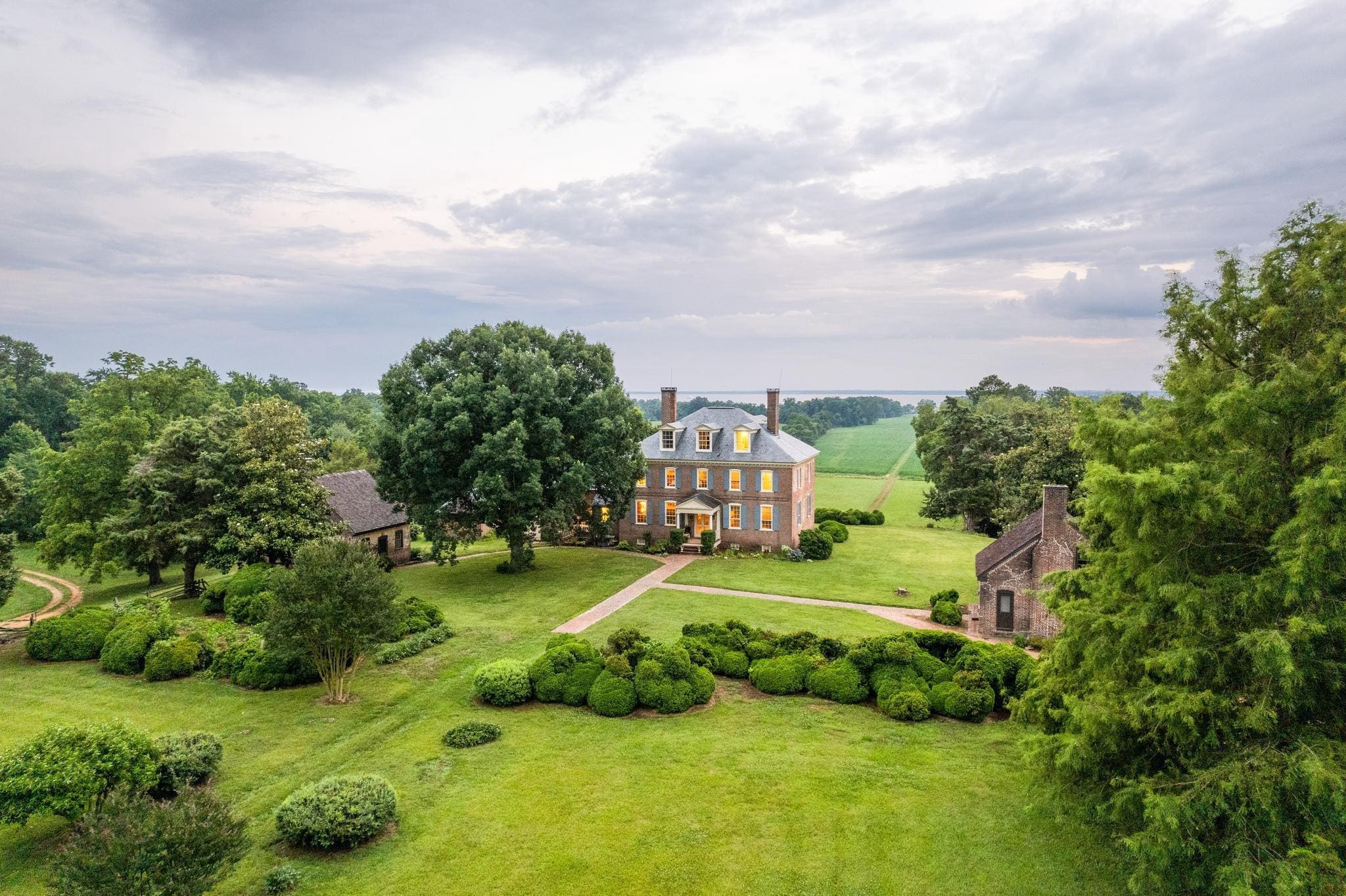
It’s hard to believe that a home built before America was even a country would still be standing, let alone up for sale. But that’s true of a formal manor house, a cultural and architectural time capsule, that was built in 1755 on farmland along the Potomac River in Maryland.
Mulberry Fields in Leonardtown consists of so much more than just the manor house. There are more than a dozen quarters, cottages and barns on the property (some historic, some added) on what was a flourishing plantation in the 18th century. Along with the buildings, the property sits on 500 acres with a stately allee of cedar trees on the south side that lead to a mile of white-sand beach on the river.
Dating to the 18th century, the manor house remains an architectural time capsule.
Long & Foster Real Estate
The manor house and property have remained in the hands of the current owners’ family for more than a century. The asking price is $30 million.
Mulberry Fields holds the sole remaining Georgian-style home in “an area which once boasted several such structures,” according to the National Register of Historic Places. The former plantation joined the historic register in 1973.
A cedar-lined driveway with split-rail fencing leads to the various structures on the site.
Long & Foster Real Estate
Outside, a driveway lined with trees leads to the house, which has an Annapolis-style facade. But it’s the riverfront entrance on the south side that claims the most attention: a large center door with two large windows at each side (in earlier times, you might arrive by boat). Around 1820, an elaborate two-story portico with long Doric columns was added.
Inside, much of the original woodwork, moldings and mantels remain intact. For example, walls of rectangular raised panels stretch to the ceiling in the great room and dining room on the first floor.
Historic details include much of the original woodwork.
Long & Foster Real Estate
There are three bedrooms on the second floor and three that make up the entire third floor. Modern additions include a kitchen, four full bathrooms and one half-bath, and air-conditioning.
The house is flanked by two stand-alone period buildings: the kitchen, which has been remodeled as a guest cottage, and the weaving house, which retains its original clapboard partition walls, floors, doors and hardware. Both have peaked roofs and brick facades. These “dependencies,” or outbuildings, once housed enslaved people who served as cooks, stable hands, servants and housekeepers.
The multiple fireplaces were once the sole sources of heating.
Long & Foster Real Estate
Other buildings on the property include a dairy, smokehouse, carriage house, garden/tool shed, several animal and equipment barns, one of which has been remodeled, farmhouse and old dwelling.
It’s not hard to imagine a modern lifestyle on the land, one with bonfires on the riverfront beach, walks in the fields and woods, and entertaining in the historic grand room.
Paneled walls enclose the formal dining room.
Long & Foster Real Estate
The house was built by John Attaway Clarke and eventually passed to his nephew, William Somerville, who had a labor force of enslaved people who worked in the fields to cultivate corn, wheat, flax and cotton in the early 1800s. The property eventually went to his son, William Clarke Somerville, the home’s most notable owner, who distinguished himself while serving as a U.S. Army major in the War of 1812.
Somerville toured Europe and rubbed shoulders with the poet Lord Byron, Britain’s famed Duke of Wellington and the Marquis de Lafayette, who fought in America’s war of independence as a young man. He received a diplomatic appointment in Greece by then President John Quincy Adams but died en route at Lafayette’s home.
One of the historic buildings is used as an art studio.
Long & Foster Real Estate
The property went through several hands before passing to the current owners, who possess architectural plans and approvals that allow for remodeling the kitchen and bathrooms as well as the addition of a new wing on the west side of the home.
Current rentals on the site produce an income of $70,000. The property has space for as many as 12 rental units. Income also is derived from farming and the U.S. Navy, which maintains a navigation signal on the river.
The two brick buildings near the manor house were used for cooking, weaving and housing enslaved … [+]
Long & Foster Real Estate
In terms of buyers, the owners are hoping the property will go to someone who will protect the historic gem. “The owners and their families for generations have been very instrumental in keeping up the history of it and not destroying it with renovations here and there,” says listing agent Kornelia Stuphan of Long & Foster Real Estate. “We would love for it to be preserved. We’re hoping for a historic trust or foundation.” Whoever winds up buying Mulberry Fields will have purchased a rare piece of American history.
Mulberry Fields is located at 19700 Mulberry Fields Road in Leonardtown, Maryland.
The river-facing facade of the manor house welcomed visitors who arrived by boat.
Long & Foster
MORE FROM FORBES GLOBAL PROPERTIES
- SEO Powered Content & PR Distribution. Get Amplified Today.
- PlatoData.Network Vertical Generative Ai. Empower Yourself. Access Here.
- PlatoAiStream. Web3 Intelligence. Knowledge Amplified. Access Here.
- PlatoESG. Carbon, CleanTech, Energy, Environment, Solar, Waste Management. Access Here.
- PlatoHealth. Biotech and Clinical Trials Intelligence. Access Here.
- Source: https://www.forbes.com/sites/forbes-global-properties/2023/11/01/30-million-manor-house-in-maryland-was-built-decades-before-america/
- :has
- :is
- :not
- $UP
- 000
- 12
- 18th
- 1973
- 500
- 66
- a
- According
- acres
- added
- addition
- additions
- Agent
- allow
- alone
- along
- also
- america
- American
- an
- and
- animal
- appointment
- approvals
- architectural
- ARE
- AREA
- Army
- around
- arrived
- Art
- AS
- asking
- At
- attention
- BE
- Beach
- been
- before
- believe
- boat
- both
- buildings
- built
- but
- buyers
- Buying
- by
- ceiling
- Center
- Century
- claims
- Columns
- consists
- cooking
- country
- Cultivate
- cultural
- Current
- dairy
- Dating
- de
- decades
- Derived
- details
- died
- dining
- diplomatic
- Distinguished
- Door
- doors
- dozen
- Duke
- each
- Earlier
- Early
- Elaborate
- entertaining
- Entire
- entrance
- equipment
- estate
- Ether (ETH)
- Europe
- Even
- eventually
- example
- Expand
- expandable
- famed
- families
- family
- farming
- farmland
- fencing
- Fields
- First
- Floor
- floors
- For
- Forbes
- Force
- formal
- Former
- Foster
- Foundation
- four
- from
- full
- Gem
- generations
- Global
- Go
- grand
- great
- Greece
- Guest
- had
- Hands
- Hard
- Hardware
- Have
- he
- here
- himself
- his
- historic
- history
- holds
- Home
- hoping
- House
- housing
- HTTPS
- imagine
- in
- include
- Income
- independence
- instrumental
- IT
- ITS
- John
- joined
- jpg
- just
- keeping
- labor
- Land
- large
- lead
- Leads
- let
- lifestyle
- lined
- listing
- located
- Long
- love
- maintains
- major
- make
- man
- many
- marquis
- Maryland
- might
- million
- Modern
- more
- most
- much
- multiple
- National
- Navigation
- Near
- New
- notable
- of
- Old
- on
- once
- ONE
- or
- original
- owner
- owners
- panels
- passed
- Passing
- peaked
- People
- period
- piece
- Places
- plans
- plantation
- plato
- Plato Data Intelligence
- PlatoData
- plus
- poet
- position
- possess
- presentation
- preserved
- president
- price
- produce
- property
- protect
- purchased
- Rail
- raised
- RARE
- real
- real estate
- received
- register
- relative
- remain
- remained
- remaining
- remains
- Rental
- rentals
- retains
- River
- road
- Room
- Route
- s
- sale
- says
- Second
- servants
- served
- serving
- several
- shed
- shoulders
- side
- Signal
- site
- sits
- So
- some
- Someone
- somerville
- son
- Sources
- South
- Space
- split
- stable
- standing
- Still
- structures
- studio
- such
- terms
- than
- that
- The
- The West
- their
- then
- There.
- These
- Third
- three
- Through
- time
- times
- to
- toured
- Trees
- true
- Trust
- two
- u.s.
- U.S. Navy
- units
- used
- various
- very
- visitors
- walks
- war
- was
- welcomed
- WELL
- went
- were
- West
- What
- which
- while
- WHO
- whoever
- will
- william
- windows
- winds
- Wing
- with
- Woods
- Woodwork
- worked
- would
- you
- young
- zephyrnet






